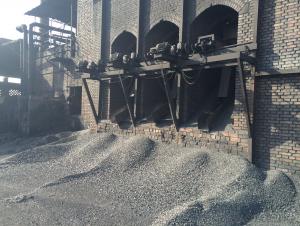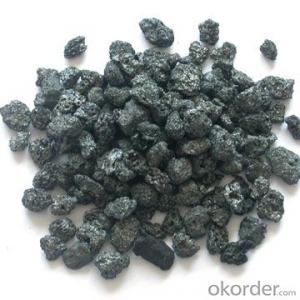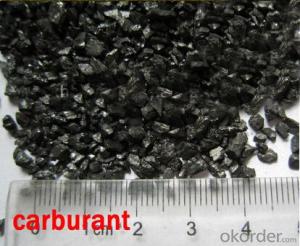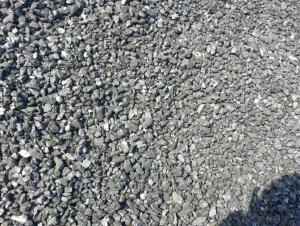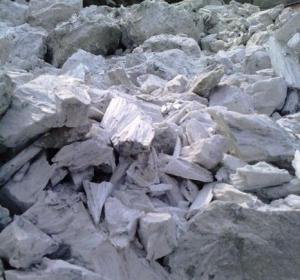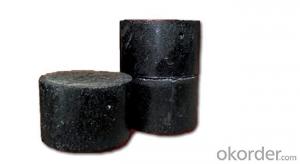FC94 Gas Calcined Anthracite/CNBM Gas Calcined Anthracite Product
- Loading Port:
- Tianjin
- Payment Terms:
- TT OR LC
- Min Order Qty:
- 0 m.t.
- Supply Capability:
- 100000 m.t./month
OKorder Service Pledge
OKorder Financial Service
You Might Also Like
Packaging & Delivery
Packaging Detail: | 25kgs/50kgs/1ton per bag or as buyer's request |
Delivery Detail: | Within 20 days after receiving corect L/C |
Feature
All of our goods are made in the best quality of world famous Tianjin. All of our products are with High carbon, Low ash, low sulphur, Low Moisture.
Usage
The Calcined Anthracite Coal/Gas Calcined Anthracite Coal/Carbon Raiser is mainly used in steelmaking in electrical stove, screening water, shipbuilding sandblast to remove rust. It can reduce the cost of steelmaking effectively by replacing the traditional petroleum coke of carburant.Also can improve the Carbon content in steel-melting and Ductile iron foundry.
Specifications
Calcined Anthracite
Fixed carbon: 90%-95%
S: 0.5% max
Size: 0-3. 3-5.3-15 or as request
PARAMETER UNIT GUARANTEE VALUE | |||||
F.C.% | 95MIN | 94MIN | 93MIN | 92MIN | 90MIN |
ASH % | 4MAX | 5MAX | 6MAX | 7MAX | 8MAX |
V.M.% | 1 MAX | 1MAX | 1.5MAX | 1.5MAX | 1.5MAX |
SULFUR % | 0.5MAX | 0.5MAX | 0.5MAX | 0.5MAX | 0.5MAX |
MOISTURE % | 0.5MAX | 0.5MAX | 0.5MAX | 0.5MAX | 0.5MAX |
Size can be adjusted based on buyer's request.
Picture


- Q:What's the difference between carbon steel pipes and stainless steel pipes and seamless steel tubes?
- As the name implies, carbon steel is made of carbon steel, forming mostly by welding, drawing, rolling, adopted the extrusion molding, and the steel tube drawing, rolling, extrusion molding are called seamless steel pipe welded steel pipe.
- Q:What's the difference between blue and red Panasonic batteries (carbon)?
- Blue is leak, proof, general, Purpose, general use battery (leak proof)Red is the long life long life battery (suitable for watches and clocks and other small power appliances)And heavy duty green seems to be good for high power appliances, such as toy cars
- Q:I want to make a rectangular round bar for bearing. What carbon fiber and carbon fiber should be used? How should I do it? What kind of machine does it use to dry it?
- Carbon fiber is not plastic, and plastic is not the same material. Carbon fiber forming process is mainly:A molding process is: by hand will prepreg paper in the mold, and then curing. This is the biggest advantage of simple manufacturing process, manual to complete more complex operations, can process the complex shape parts, suitable for small batch production; the disadvantage is low efficiency and poor labor conditions, labor intensity is big.Filament winding forming technology: the earliest continuous forming process, that is, the fiber is dipped into the resin through the resin trough, and then wrapped on the rotating core mold according to certain rules. Then, the glue is solidified and formed by heating. A prominent feature is that it is in accordance with the stress situation of products, the fiber according to a certain rule arrangement, so as to give full play to the strength of the fiber, obtain the lightweight products; can realize continuous and mechanized production in the process, and short production cycle, high production efficiency, low labor intensity, suitable for manufacturing cylinder the sphere, and some positive curvature gyration bodies or tubular products.
- Q:Carbon injection molding machine heating several degrees
- The nozzle temperature is 260~310 degrees, and the temperature control of the two types of injection molding machine nozzles is different. The mold temperature has great influence on the mechanical properties of the products. With the increase of mold temperature. The temperature and the temperature difference between the temperature decreases, the shear stress decreases, can melt in the mold cavity slow cooling, the molecular chain orientation to relaxation reduced, thereby reducing the internal stress of products, but the impact strength and elongation of the products decreased significantly, while there will be demolding. When demoulding, it is easy to deform, prolong the molding cycle and reduce the production efficiency, while the lower mold temperature will increase the internal stress of the product. Therefore, the die temperature must be controlled. Normally, the mold temperature of PC is 80~120 degrees centigrade. Ordinary products are controlled at 80~100 degrees, while for complex shapes, thin walls and high requirements, the product is controlled at 100~120 degrees centigrade and is not allowed to exceed its thermal deformation temperature. Mold temperature control is particularly important when forming PC thick wall products.
- Q:What is carbon offsetting in the fashion industry?
- Carbon offsetting in the fashion industry refers to the practice of compensating for the greenhouse gas emissions produced during the production, transportation, and disposal of clothing and accessories. This process involves investing in projects or activities that reduce or remove an equivalent amount of carbon dioxide (CO2) from the atmosphere to offset the emissions generated by the industry. Fashion is known for its significant contribution to environmental degradation, with the production of textiles, manufacturing processes, and transportation all contributing to carbon emissions. Carbon offsetting provides a way for fashion brands and companies to take responsibility for their carbon footprint and work towards reducing their environmental impact. There are various ways in which carbon offsetting is implemented in the fashion industry. One common method is through the support of renewable energy projects, such as wind farms or solar power plants, which generate clean energy and reduce the reliance on fossil fuels. By investing in these projects, fashion brands can offset a portion of their emissions by supporting the production of renewable energy that displaces the need for fossil fuel-based energy sources. Another approach to carbon offsetting is through reforestation or afforestation projects. Trees play a crucial role in absorbing CO2 from the atmosphere, so planting trees or conserving existing forests can help offset emissions. Fashion companies can invest in projects that protect existing forests from deforestation or support initiatives that plant trees in areas affected by deforestation or land degradation. Moreover, some fashion brands opt for carbon offsetting by investing in projects that capture and store carbon dioxide from the atmosphere, such as carbon capture and storage (CCS) technologies. These projects focus on removing CO2 emissions from industrial processes, preventing them from being released into the atmosphere. It is important to note that carbon offsetting should not be seen as a complete solution to the fashion industry's environmental impact. While it can help mitigate some of the emissions, it is crucial for brands to prioritize reducing their carbon footprint through sustainable practices, including using eco-friendly materials, improving energy efficiency, and implementing circular fashion initiatives. Overall, carbon offsetting in the fashion industry is a strategy to compensate for the greenhouse gas emissions generated throughout the supply chain. By investing in projects that reduce or remove an equivalent amount of CO2 from the atmosphere, fashion brands can take steps towards minimizing their environmental impact and working towards a more sustainable future.
- Q:What are the different types of carbon-based drugs?
- There are several categories in which carbon-based drugs can be classified, based on their chemical structure and mode of action. One of the most common categories is alkaloids, which are naturally occurring compounds found in plants and have powerful pharmacological effects. Examples of carbon-based alkaloid drugs include morphine, codeine, and cocaine. Another category of carbon-based drugs is steroids. Steroids are compounds characterized by a carbon skeleton consisting of four fused rings. They are widely used in medicine because of their anti-inflammatory and immunosuppressive properties. Examples of carbon-based steroid drugs include cortisone, prednisone, and estrogen. Additionally, carbon-based drugs can be classified as nonsteroidal anti-inflammatory drugs (NSAIDs). These drugs work by inhibiting the action of cyclooxygenase enzymes, which reduces pain, inflammation, and fever. Common carbon-based NSAIDs include aspirin, ibuprofen, and naproxen. Furthermore, carbon-based drugs can be categorized as antibiotics. These are compounds derived from microorganisms or synthesized artificially that hinder the growth of bacteria or other microorganisms. Examples of carbon-based antibiotic drugs include penicillin, tetracycline, and erythromycin. Lastly, carbon-based drugs can also be synthetic compounds designed to target specific receptors or pathways in the body. These drugs are often created through extensive research and testing to treat various diseases and conditions. Examples of such drugs include cholesterol-lowering statins, antipsychotic medications, and anti-cancer drugs. To sum up, carbon-based drugs can be classified into alkaloids, steroids, NSAIDs, antibiotics, and synthetic compounds. Each category consists of drugs with diverse chemical structures and mechanisms of action, allowing for a wide range of therapeutic applications in the field of medicine.
- Q:What is carbon black ink?
- Carbon black ink is a type of ink that contains carbon black pigment as its main component. Carbon black is a fine powder made from carbon, which is produced by incomplete combustion of hydrocarbons. In the ink industry, carbon black is commonly used as a pigment due to its intense black color and ability to provide good opacity and UV resistance. Carbon black ink is widely used in various applications such as printing, writing, and drawing. It is commonly found in ballpoint pens, fountain pens, markers, and printer inks. The ink's high concentration of carbon black pigment ensures a deep, solid black color when applied on paper or other surfaces. One of the advantages of carbon black ink is its durability. It has excellent lightfastness, meaning it resists fading or discoloration when exposed to light over time. This is particularly important in applications where long-lasting or archival quality ink is required, such as in art or document preservation. Additionally, carbon black ink has good water resistance and adhesion properties, making it suitable for use on various substrates, including paper, cardboard, and plastics. Its high viscosity ensures smooth and consistent ink flow, allowing for precise and consistent writing or printing. Overall, carbon black ink is a reliable and versatile type of ink that offers intense black color, excellent durability, and good adhesion properties. Its widespread use in various writing and printing applications is a testament to its quality and reliability.
- Q:What are the consequences of increased carbon emissions on forest ecosystems?
- Increased carbon emissions have significant consequences on forest ecosystems. One of the most notable impacts is the alteration of the climate and weather patterns. The excessive carbon dioxide in the atmosphere traps heat, leading to global warming. This rise in temperature can disrupt the delicate balance of forest ecosystems. Warmer temperatures can cause shifts in the distribution and composition of tree species, as some may struggle to adapt to the changing conditions. Another consequence of increased carbon emissions is the acidification of rainwater. When carbon dioxide combines with water vapor, it forms carbonic acid, which can fall as acid rain. Acid rain has detrimental effects on forest ecosystems, as it leaches important nutrients from the soil and damages tree leaves and other vegetation. This can weaken the overall health of the forest and make them more susceptible to diseases and pests. Furthermore, increased carbon emissions contribute to the intensification of wildfires. Higher temperatures and drier conditions provide the perfect environment for fires to spread and become more frequent. Forests that have evolved to withstand natural fire regimes may struggle to cope with the increased intensity and frequency of these fires. This can lead to the loss of biodiversity, destruction of habitat, and long-term degradation of forest ecosystems. Lastly, increased carbon emissions contribute to the phenomenon known as ocean acidification, where excess carbon dioxide is absorbed by the oceans. This acidification can affect the health of coastal and marine ecosystems, which are intricately connected to forest ecosystems. Many forest ecosystems, such as mangroves and salt marshes, provide vital nursery habitats for marine species. If these forest ecosystems decline due to carbon emissions, it can have cascading effects on the health and productivity of coastal and marine ecosystems. Overall, increased carbon emissions have far-reaching consequences on forest ecosystems. It alters climate patterns, causes acid rain, intensifies wildfires, and affects coastal and marine ecosystems. These impacts not only harm the trees and vegetation within the forests but also disrupt the delicate balance of the entire ecosystem, leading to loss of biodiversity and long-term degradation. It is crucial to mitigate carbon emissions and promote sustainable practices to minimize these consequences and preserve the health and integrity of forest ecosystems.
- Q:Is carbon monoxide good for people?
- Carbon monoxide is a common poison, but trace use is good for organ transplants. British researchers have recently developed a new method that can effectively use carbon monoxide to help transplant organs survive, while avoiding the risk of carbon monoxide poisoning.Excessive inhalation of carbon monoxide poisoning will lead to death, carbon monoxide into the human body, and soon the hemoglobin in blood combined with the formation of carboxyhemoglobin, causes red blood cells to reduce the oxygen carrying, the tissue hypoxia in vivo. The cardiac and central biblical system is the most sensitive to hypoxia and the earliest affected. In the air of carbon monoxide concentration reached 117 mg / M 3, people can feel headache, vertigo: up to 292.5 mg / M 3 symptoms; up to 582.5 mg / M 3 will be nausea and vomiting, exhaustion, if not timely rescue can have life risk. When the concentration of carbon monoxide in the air reaches 11700 mg / M 3, a coma occurs; the concentration of carbon monoxide in the air reaches 1170 mg / m. The 3 spoons will soon die.
- Q:What are the benefits of carbon-neutral technologies?
- Carbon-neutral technologies have numerous benefits, including the reduction of greenhouse gas emissions, mitigating climate change, and improving air quality. They also promote energy efficiency, stimulate innovation and job creation in the clean energy sector, and enhance energy security by reducing reliance on fossil fuels. Furthermore, carbon-neutral technologies contribute to sustainable development, foster international cooperation, and create a healthier and more sustainable future for all.
1. Manufacturer Overview |
|
|---|---|
| Location | |
| Year Established | |
| Annual Output Value | |
| Main Markets | |
| Company Certifications | |
2. Manufacturer Certificates |
|
|---|---|
| a) Certification Name | |
| Range | |
| Reference | |
| Validity Period | |
3. Manufacturer Capability |
|
|---|---|
| a)Trade Capacity | |
| Nearest Port | |
| Export Percentage | |
| No.of Employees in Trade Department | |
| Language Spoken: | |
| b)Factory Information | |
| Factory Size: | |
| No. of Production Lines | |
| Contract Manufacturing | |
| Product Price Range | |
Send your message to us
FC94 Gas Calcined Anthracite/CNBM Gas Calcined Anthracite Product
- Loading Port:
- Tianjin
- Payment Terms:
- TT OR LC
- Min Order Qty:
- 0 m.t.
- Supply Capability:
- 100000 m.t./month
OKorder Service Pledge
OKorder Financial Service
Similar products
New products
Hot products
Hot Searches
